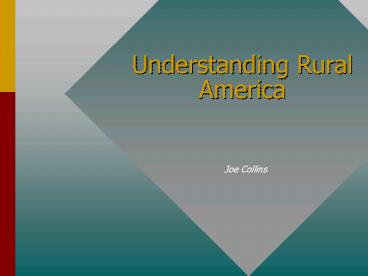Understanding Rural America - PowerPoint PPT Presentation
1 / 13
Title: Understanding Rural America
1
Understanding Rural America
Joe Collins
2
Introduction
- This report aims to provide objective
information about the changes taking place in and
the diversity of rural America. Toward the end,
the report looks at change and diversity from
several angles - its people and places, its
economies and industries, its concerns and
future. The report begins by examining the
shifts in rural employment, population, and
well-being, continues by analyzing six county
types, and concludes by outlining key realities
that effective rural policy will need to
recognize. (ERS, 1992)
3
Is Rural America Unique?
- The People and Places in Rural America, certainly
depend upon many things in order to function
properly. - Likewise, many communities within Rural America,
have hardships and problems that remain unsolved
at the present time.
4
Rural America is a Vital and Changing part of our
Nation
- Rural America today comprises
- 2,288 counties
- 83 of the Nations land
- Home to 21 (5 million) of the people of the
United States - Supplies 18 of all the Nations jobs
(Manufacturing, Mining, Recreational Services,
and of course Agriculture) - Supplies 14 of the Nations earnings .
5
Rural Employment is shifting from farming to
manufacturing
- Farming
- Once considered synoymous with rural,
unfortunately that is no longer the case. - It is still the single largest user of rural
land, but it no longer dominates rural industry.
6
Farming
- The decline of farming employment is, in many
ways a consequence of success. Improvements in
technology, crop science, and farm management
have all boosted output while reducing the need
for labor. Productivity growth has in turn, led
to farm consolidation, declining farm numbers,
decreases in farm employment, and consequently a
surplus of farm labor. Thus, the ability to
produce more with less, while benefiting many,
has caused economic hardship for others (ERS,
1992).
7
Rural Population is Growing in some areas, but
Declining in others.
- In the 1970s, Migration to rural areas
increased. - In the 1980s, Migration trend reversed and
turned into a time of crisis for the farm as well
as a recession for business. - In the 1990s, Rebound occurred in the rural
areas and resulted in a softness in the national
economy has been more urban than rural ever since.
8
The Rural well-being
- Improvements
- Visable improvements include electricity,
telephone service, and a highway system. - Housing
- Gaps
- Real earnings per job are consistently and have
been substantially lower since 1979. From 1979
1989, Real earnings per job as well as college
completion rates declined by 6.5. - Population subgroups prone to economic
disadvantages
9
Rural Diversity
- Rural America is diverse in many ways. No one
industry dominates the rural economy, no single
pattern of population decline or growth exists
for all rural areas and no statement bout
improvements and gaps in well being holds true
for all rural people.
10
Different challenges means Different solutions.
- Geographic Region
- Six types of Non-metro counties
- Each county while overcoming significant barriers
in the past, still are faced with overcoming
significant barriers in the future.
11
Conclusions
- The diversity of rural America means different
areas have different needs. - There is an overall pattern of economic
disadvantage in rural areas.
12
Furthermore
- Rural settlement patterns tend to be small in
scale and low in density. - The natural resource based industries on which
many rural areas have traditionally depended are
declining as generators of jobs and income. - Low-skill, Low wage rural labor faces
increasingly fierce global competition. - Finally, Distance and remoteness impede rural
areas from being connected to the urban centers
of economic activity.
13
The End































